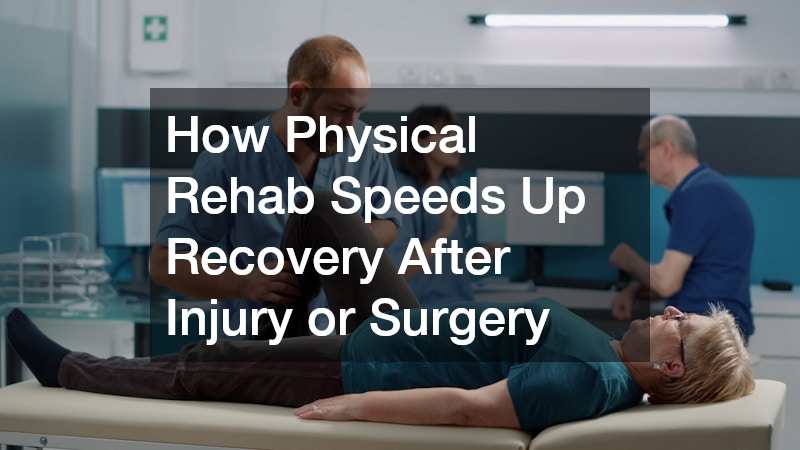
Physical rehabilitation is a pivotal component of the recovery process following an injury or surgical procedure. It plays a significant role in restoring functionality, reducing pain, and enhancing overall recovery outcomes. This article explores how physical rehabilitation expedites the healing process, addressing common queries and concerns associated with it.
The Role of Physical Therapy in Healing
Physical therapy is an essential element in post-injury recovery, helping patients regain strength, mobility, and function. In the initial phases, therapists assess the patient’s condition to create a personalized rehabilitation plan tailored to individual needs.
This personalized approach fosters a more adaptive and effective recovery, ensuring that therapy sessions target specific areas of concern in the healing process.
Communication between healthcare providers and patients is crucial in this setting, allowing ongoing reassessment and modification of therapy plans as needed. Through structured rehabilitation exercises, patients progressively rebuild their muscle strength and joint capability. The ultimate goal is not only to restore the patient to their pre-injury state but to enhance their overall physical resilience, reducing the likelihood of future injuries.
Prevention of Complications
Rehabilitation mitigates the risk of complications such as muscle atrophy, stiffness, and chronic pain, facilitating a smoother recovery. Without proper physical rehabilitation, the likelihood of permanent immobility or reduced functionality increases, particularly after severe injuries or surgeries. By engaging in regular therapeutic activities, patients maintain muscle tone and joint flexibility, reducing post-operative complications.
Muscle atrophy is often a concern for those who have spent prolonged periods immobilized, as it can lead to significant functional deficits. Physical rehabilitation counteracts this by employing specific resistance and strength-building exercises designed to preserve and enhance muscle mass. This is crucial in preventing secondary health issues that may arise from prolonged immobility, such as deep vein thrombosis or pressure sores.?
Advanced Technologies in Physical Rehab
Technological advancements like hydrotherapy, laser therapy, and electrical stimulation accelerate healing when integrated into a rehab regimen. Hydrotherapy utilizes water-based exercises to support weight, making physical movements less strenuous and more accessible to those with severe mobility impairments. The buoyant properties of water reduce the risk of strain, allowing patients to engage in low-impact activities that promote strength and flexibility.
Laser therapy involves using focused light to stimulate cellular function and reduce inflammation in targeted areas. This non-invasive treatment is particularly effective in managing pain and enhancing tissue repair processes. Patients often experience quicker recovery times and reduced pain levels when laser therapy is incorporated into their rehabilitation plan.
Factors Influencing Rehab Duration
The extent of injury, patient’s age, and pre-existing health conditions are key factors that determine the length of the rehabilitation period. Severe injuries often require prolonged rehabilitation to ensure full recovery, while minor injuries may resolve with shorter intervention. The patient’s motivation and commitment to the rehab process significantly influence the duration and success of recovery.
Moreover, age is a critical factor, as younger individuals typically heal faster due to greater biological regenerative capacity. However, older adults may experience an extended rehab period because of pre-existing health issues or age-related declines in healing efficiency. An individual’s overall health, such as chronic conditions or lifestyle factors, also impacts rehabilitation timelines.
Typical Rehab Timelines for Common Injuries
A detailed overview of recovery timelines for injuries such as fractures, sprains, and post-operative recovery. Fractures typically require immobilization followed by several weeks to months of rehabilitation to regain function. For sprains, especially in joints like the ankle, rehab can span weeks, focusing on regaining stability and preventing recurrence.
Post-operative recovery, like knee or hip replacements, often involves a structured rehabilitation protocol extending over several months. This period allows for gradual reintegration of functional movements, strengthening of surrounding musculature, and restoration of joint range of motion. Each stage of rehabilitation builds on the previous, ensuring that patients can meet physical demands incrementally and safely.
The Importance of Adherence to Rehab Protocols
Consistent participation in prescribed therapies and exercises ensures optimal recovery and prevention of re-injury. Adherence is pivotal; without it, the risk of complications, delayed healing, and long-term impairments increase significantly. It is crucial for patients to understand and commit to their rehabilitation protocols as part of their recovery responsibility.
Healthcare providers play an essential role in fostering adherence by offering motivation, education, and support throughout the rehabilitation journey. By providing clear instructions and feedback, therapists can enhance the patient’s understanding and execution of their physical rehabilitation practices. This engagement empowers patients, leading to increased self-efficacy and more reliable therapy outcomes.
Physical rehabilitation is integral to an effective recovery process after injury or surgery. By understanding its importance, types, and duration, patients and healthcare providers can collaboratively work towards a successful rehabilitation journey, enhancing both physical and mental well-being.




